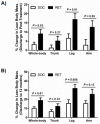Early rehabilitative exercise training in the recovery from pediatric burn
- PMID: 24824900
- PMCID: PMC4122649
- DOI: 10.1249/MSS.0000000000000296
Early rehabilitative exercise training in the recovery from pediatric burn
Abstract
Purpose: The purpose of this study was to determine the effects of early outpatient exercise on muscle mass, function, and fractional synthetic rate in severely burned children.
Methods: Forty-seven children with ≥40% total body surface area burn performed a 12-wk standard of care rehabilitation (SOC, n = 23) or rehabilitative exercise training (RET, n = 24) immediately after hospital discharge. Dual-energy x-ray absorptiometry was used to assess lean body mass (LBM) at discharge, posttreatment, and 12 months post-burn. Muscle function was evaluated with a Biodex Isokinetic Dynamometer, and peak aerobic fitness (V˙O2peak) was measured using a modified Bruce treadmill protocol posttreatment. Stable isotope infusion studies were performed in a subset of patients (SOC, n = 13; RET, n = 11) at discharge and posttreatment to determine mixed-muscle fractional synthetic rate.
Results: Relative peak torque (RET, 138 ± 9 N·m·kg, vs SOC, 106 ± 9 N·m·kg) and V˙O2peak (RET, 32 ± 1 mL·kg·min, vs SOC, 28 ± 1 mL·kg·min) were greater at posttreatment with RET compared with those with SOC. In addition, RET increased whole-body (9% ± 2%) and leg (17% ± 3%) LBM compared with SOC. Furthermore, the percentage change in whole-body (18% ± 3%) and leg (31% ± 4%) LBM from discharge to 12 months post-burn was greater with RET compared to SOC. Muscle fractional synthetic rate decreased from discharge to posttreatment in both groups (6.9% ± 1.1% per day vs 3.4 ± 0.4% per day); however, no differences were observed between treatment groups at each time point.
Conclusions: Early outpatient exercise training implemented at hospital discharge represents an effective intervention to improve muscle mass and function after severe burn injury.
Trial registration: ClinicalTrials.gov NCT00675714.
Figures



References
-
- Burn Incidence and Treatment in the United States: 2012 Fact Sheet. Sources: National Electric Injury Surveillance System-All Injury Project (NEISS-AIP); National Emegency Department Survey (HCUP-NEDS) (2010 Data); National Ambulatory Medical Care Survey; Dec 21, 2013. American Burn Association Web site [Internet] cited. Available from: http://www.ameriburn.org/resources_factsheet.php.
-
- Alloju SM, Herndon DN, McEntire SJ, Suman OE. Assessment of muscle function in severely burned children. Burns. 2008;34(4):452–9. - PubMed
-
- Biolo G, Fleming RY, Maggi SP, Nguyen TT, Herndon DN, Wolfe RR. Inverse regulation of protein turnover and amino acid transport in skeletal muscle of hypercatabolic patients. J Clin Endocrinol Metab. 2002;87(7):3378–84. - PubMed
-
- Biolo G, Fleming RY, Maggi SP, Wolfe RR. Transmembrane transport and intracellular kinetics of amino acids in human skeletal muscle. Am J Physiol. 1995;268(1 Pt 1):E75–84. - PubMed
Publication types
MeSH terms
Associated data
Grants and funding
LinkOut - more resources
Full Text Sources
Other Literature Sources
Medical

